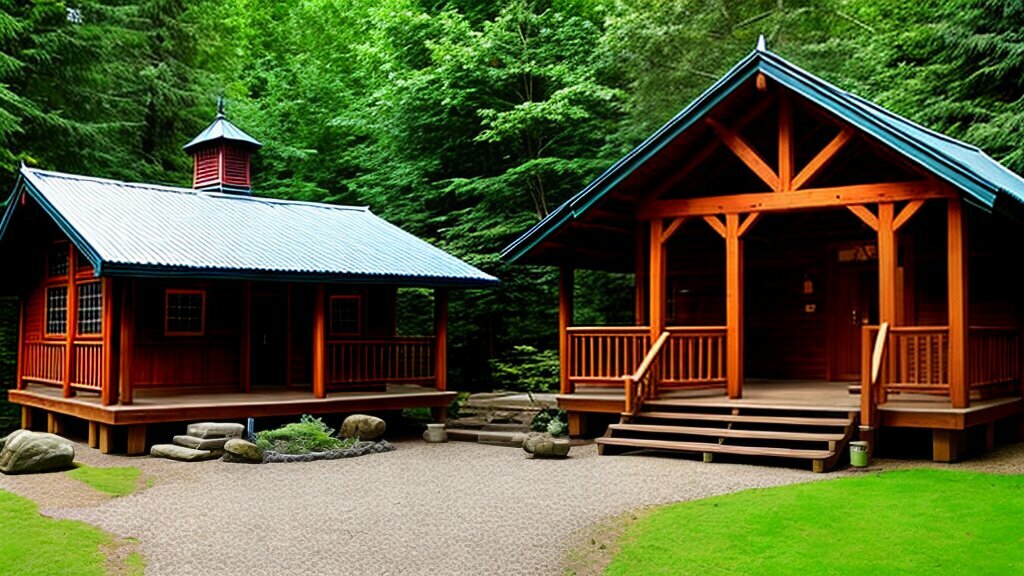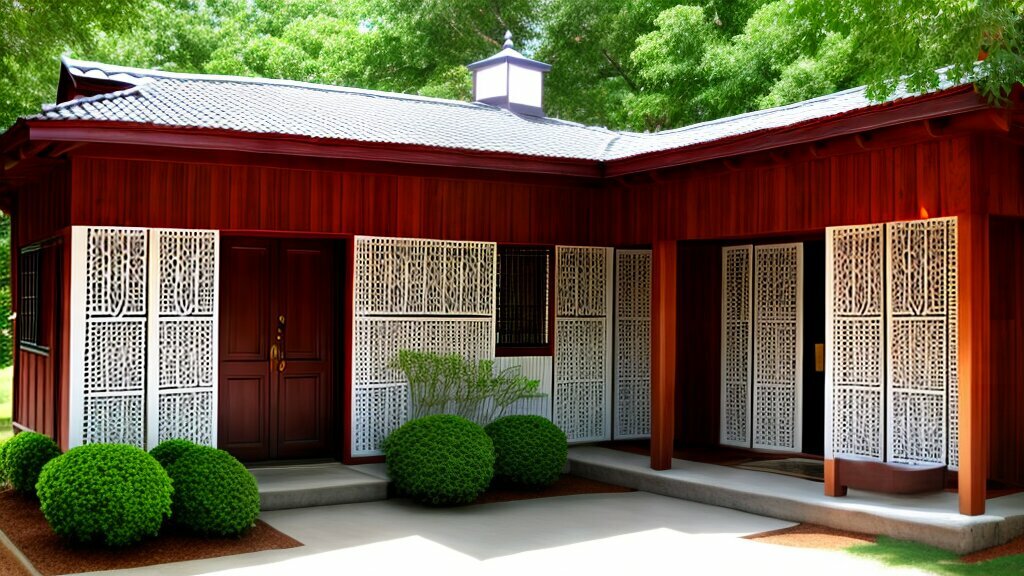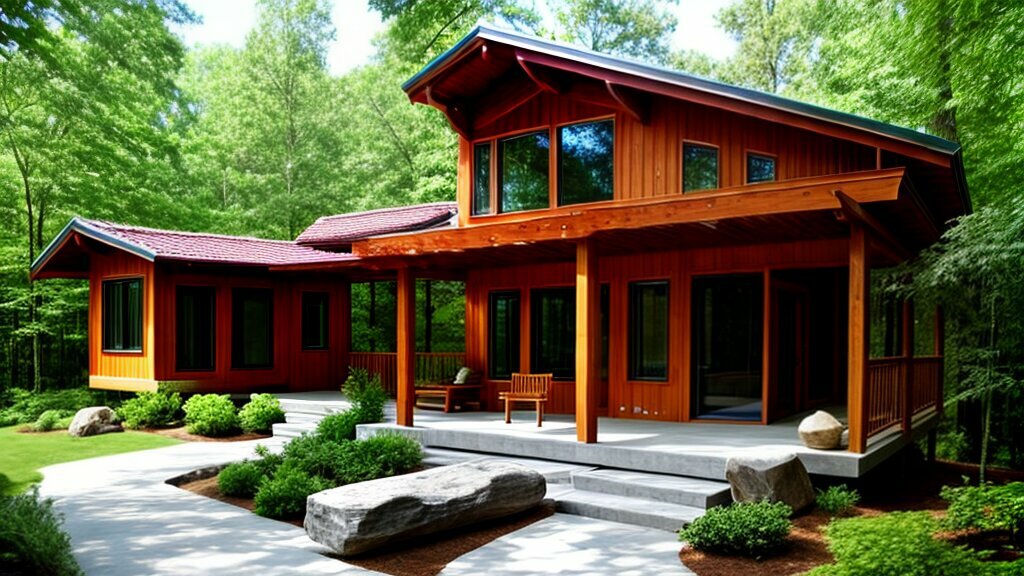Sacred Spaces: The Spiritual Dimensions of Indigenous Architecture
Indigenous architecture is much more than just a physical structure; it is an embodiment of the culture and beliefs of indigenous communities. Each building reflects a deep spiritual connection with nature and a reverence for the ancestors. The spiritual dimensions of indigenous architecture are crucial to understanding the significance of these structures to the people who inhabit them.
From the towering totem poles of the Pacific Northwest to the intricate adobe structures of the Southwest, indigenous architecture across the world is characterized by a unique blend of functionality, aesthetic appeal, and spiritual significance. The designs have been passed down through generations, and their cultural significance has remained intact.
The spiritual dimensions of indigenous architecture go beyond mere aesthetics and architectural elements. The structures serve as a conduit for the community’s rituals, ceremonies, and spiritual practices. They are sacred spaces where people can connect with the spirit world and the natural environment.
Indigenous architecture is a testament to the power of cultural traditions and the resilience of indigenous cultures in preserving their unique heritage.
Key Takeaways:
- Indigenous architecture reflects the cultural identity and spiritual beliefs of indigenous communities.
- The design and placement of indigenous structures harmonize with the natural environment, fostering a sense of spiritual connection.
- Patterns, motifs, and geometric shapes in indigenous architecture hold deep spiritual meanings and serve as a visual language for indigenous communities.
The Significance of Traditional Architecture in Indigenous Cultures
Indigenous architecture is a reflection of the cultural identity of indigenous communities. Traditional architectural elements and techniques serve to preserve cultural heritage, and the design and construction of indigenous buildings are deeply rooted in indigenous beliefs and values.
For many indigenous communities, traditional architecture goes beyond simply providing shelter. Indigenous structures represent a connection to the land and its history, and are often built using materials sourced from the surrounding environment. The design and placement of these structures also harmonize with nature, fostering a sense of spiritual connection.
Traditional building techniques, such as adobe brick making or thatched roofing, are passed down through generations, preserving cultural knowledge and expertise. Techniques like these are not only practical but also symbolic, representing the values and beliefs of the indigenous community.
Furthermore, traditional architectural elements often contain symbolic meanings, such as geometric shapes or patterns used in decoration. These motifs are deeply connected to indigenous spirituality, representing the community’s connection to the natural world and their ancestors.
Preserving traditional architecture is crucial to the cultural identity and spiritual beliefs of indigenous communities. It serves as a reminder of their rich history and the values that they hold dear. As Christopher Alexander once said, “Each community’s physical environment is unique, reflecting its own culture and social structure. Good architecture is produced by understanding and responding to these unique qualities of a place.”

Indigenous architecture is a testament to the ingenuity and adaptability of indigenous communities, as well as their spiritual connection to the land and its history. By preserving these structures, we can honour their culture and ensure that their traditions continue to thrive for generations to come.
The Connection with Nature in Indigenous Architecture
The connection with nature is a fundamental aspect of indigenous cultures, and this is reflected in their architectural designs. Indigenous structures are designed to blend in with the natural environment and harmonize with the surrounding landscape. The placement and orientation of buildings are determined by the natural features of the site, such as the direction of the sun, the flow of water, and the topography of the land. This creates a sense of unity with nature, fostering a deep spiritual connection and a sense of belonging.
Indigenous communities see the natural world as a sacred entity and view themselves as caretakers of the land. Therefore, their architecture is built with sustainability and respect for the environment in mind. The use of locally sourced materials and traditional building techniques allows for a minimal impact on the ecosystem while ensuring the longevity of the structures.

The design of indigenous buildings is also influenced by the natural elements. For example, circular structures are common in indigenous architecture as they represent the cyclical nature of life and the seasons. The use of natural materials such as wood, stone, and earth gives the buildings an organic feel, further reinforcing the connection with nature.
Ritualistic Designs and Architectural Symbolism
Indigenous architecture is filled with intricate patterns and motifs that hold deep spiritual meanings. These designs often serve as a visual language, conveying important stories and beliefs within indigenous communities.
Geometric shapes are commonly used in indigenous architecture, representing various aspects of the natural world. For example, the circle symbolizes unity and wholeness, while the spiral represents growth and transformation.
The use of symbols and patterns in indigenous architecture is not just decorative; it serves a ritualistic purpose as well. Many indigenous buildings feature these designs as a way to protect and bless the structure, warding off negative energies and inviting positive ones. The intricate designs on the doors and windows of the Tlingit longhouse, for example, serve as a form of protection against evil spirits.

“The use of symbols and patterns in indigenous architecture is not just decorative; it serves a ritualistic purpose as well.”
These designs are often created using materials that hold special significance within the community. For example, the Maori use woven flax panels in their meeting houses, called marae. The panels are decorated with traditional designs called kowhaiwhai, which represent different tribes and their stories. The use of flax in this manner not only reinforces the connection with nature but also serves as a reminder of traditional Maori values and customs.
The use of architectural symbolism in indigenous buildings is a testament to the deep spiritual connection between these structures and the communities that create them. The intricate designs and motifs not only serve a practical purpose but also convey important stories and beliefs that have been passed down for generations.
Indigenous Rituals and Beliefs Embedded in Architecture
Indigenous architecture is not just a matter of utility and function, but it is also steeped in the spiritual beliefs and rituals of the communities that create them. Indigenous peoples have a unique understanding of the world around them, and their architecture reflects their connection to the land, their traditions and customs and their belief systems.
The designs of indigenous buildings are created with the intention of serving as a place of worship, a dwelling for ancestors, or as a physical representation of spiritual beliefs. For example, in the Lakota Native American tradition, the design of their tipis is imbued with spiritual meaning. The circular shape symbolizes the cycle of life, while the entrance, which always faces east, represents the direction from which the sun rises, symbolizing a new day and new beginnings. The poles of the tipi represent the connection between earth and sky and are placed in a specific order to reflect the spiritual hierarchy of the community.
Similarly, the Maori meeting houses, or whare whakairo, of New Zealand, are intricately adorned with ancient symbols, patterns and carvings that hold deep spiritual significance. The carvings represent the ancestors and tell the stories of the community’s history and traditions. The building’s orientation is also significant, with the front of the whare whakairo facing east towards the rising sun, which is a symbol of new beginnings and renewal.
Indigenous communities also use their architecture to connect with the natural world and the spiritual beings that inhabit it. For example, in the Inuit tradition, the igloo is designed to withstand the harsh Arctic climate while also providing a space for spiritual reflection and connection with the natural world. The igloo’s round shape represents harmony with the environment, and the snow blocks used to build it are a physical manifestation of the Inuit’s connection to the land.
Indigenous communities have a deep connection to their spiritual beliefs and practices. Through their architecture, these practices and beliefs are woven into the very fabric of their buildings, ensuring that the spiritual dimensions of indigenous architecture are preserved for future generations to learn and appreciate.

The Spiritual Dimensions of Indigenous Architecture: Examples from Around the World
Indigenous architecture showcases an intricate relationship between spirituality and design, with sacred spaces being an integral part of indigenous cultures. Here are some examples of indigenous architectural wonders from around the world that reflect the spiritual dimensions ingrained in their design:
1. Machu Picchu, Peru

Ancient Incan architecture at Machu Picchu in Peru exemplifies the connection between indigenous architecture and spirituality. The design of the city is in perfect harmony with the surrounding natural environment, and built-in astronomical alignments reflect the Incan belief in the interconnection between the cosmos and the earth. The Intihuatana stone, or “hitching post of the sun,” is one of the most notable features and may have been used in religious ceremonies.
2. Great Serpent Mound, Ohio, USA
The Great Serpent Mound in Ohio, USA, is a massive effigy mound in the shape of a serpent. Although its origins and purpose are not entirely clear, many believe it to be a sacred site related to indigenous spiritual beliefs. The serpent is a common theme in many Native American belief systems, symbolizing power, renewal, and protection. The mound’s location aligns with the summer solstice sunrise and sunset, further emphasizing its spiritual significance.
3. The Longhouse, North America
The longhouse is a traditional dwelling among many indigenous communities in North America, and its design reflects the importance of communal living. It is a symbol of unity, with the entire community living under one roof. The longhouse is also a place of spiritual gathering, where ceremonies and rituals take place. The design of the longhouse itself may reflect the community’s belief systems and their connection with nature.
These are just a few examples of how indigenous architecture can reflect the spiritual dimensions of indigenous cultures. They serve as a testament to the important connection between architecture and spirituality. Preserving these sacred spaces is crucial in maintaining and celebrating the rich heritage and belief systems of indigenous communities.
Conclusion
Indigenous architecture is much more than just a physical structure; it is a reflection of the spiritual beliefs and cultural identity of indigenous communities. Throughout the world, indigenous architects have designed structures that blend seamlessly with the natural environment and hold deep symbolic meanings.
It is essential to recognize and preserve these sacred spaces as a testament to indigenous cultures’ rich heritage and belief systems. By doing so, we can pay homage to the spiritual dimensions of indigenous architecture and appreciate the crucial role it plays in indigenous communities.
FAQ
Q: What are the spiritual dimensions of indigenous architecture?
A: The spiritual dimensions of indigenous architecture refer to the sacred spaces and the connection with nature that are integral to indigenous cultures. Indigenous architecture often reflects the spiritual beliefs, rituals, and symbolism of indigenous communities.
Q: How does traditional architecture contribute to the cultural identity of indigenous communities?
A: Traditional architecture plays a significant role in preserving the cultural identity of indigenous communities. It incorporates architectural elements and techniques that have been passed down through generations, showcasing the unique cultural heritage of these communities.
Q: How is the connection with nature reflected in indigenous architecture?
A: Indigenous architecture is deeply rooted in the connection with nature. The design and placement of indigenous structures are often harmonized with the natural environment, creating a sense of spiritual connection and reverence for the natural world.
Q: What is the role of ritualistic designs and architectural symbolism in indigenous architecture?
A: Ritualistic designs and architectural symbolism hold deep spiritual meanings in indigenous architecture. Patterns, motifs, and geometric shapes are used as a visual language, conveying cultural and spiritual significance within indigenous communities.
Q: How are indigenous rituals and beliefs embedded in architecture?
A: Indigenous rituals and beliefs are intricately woven into the fabric of architectural designs. The layout, construction, and use of indigenous buildings are influenced by spiritual ceremonies and practices, which shape the overall design and purpose of the structures.
Q: Can you provide examples of spiritual dimensions in indigenous architecture?
A: There are numerous examples of indigenous architectural wonders around the world that exhibit spiritual dimensions in their design. Some notable examples include the Mayan temples of Chichen Itza, the Aboriginal rock art sites in Australia, and the Inca ruins of Machu Picchu.
Q: What is the importance of recognizing and preserving the spiritual dimensions in indigenous architecture?
A: Recognizing and preserving the spiritual dimensions in indigenous architecture is crucial in honoring and respecting indigenous cultures’ rich heritage and belief systems. These sacred spaces serve as a testament to the spiritual practices and traditions that have sustained indigenous communities for centuries.









Colonial Impact and Indigenous Architecture: Design
2 years ago[…] Indigenous Architecture is a reflection of cultural heritage, and its preservation is vital to the identity of indigenous communities. Colonization architecture, however, often disregarded traditional indigenous design principles, replacing them with styles and techniques imposed by colonial powers. Understanding the colonial impact on Indigenous Architecture is essential to appreciating the resilience of indigenous building traditions throughout history. […]